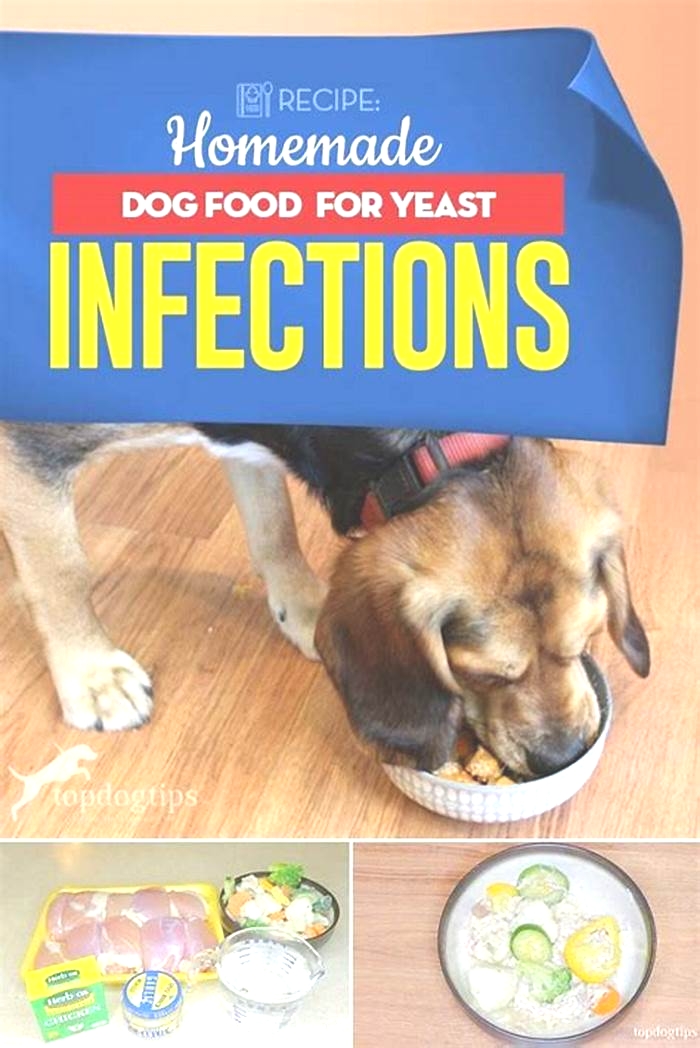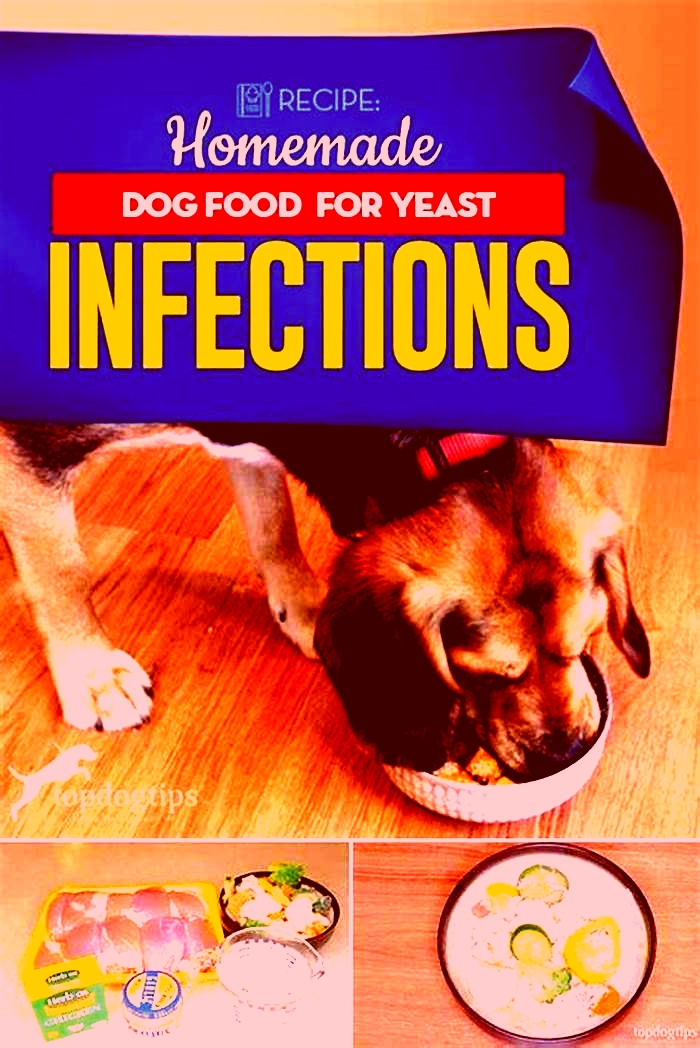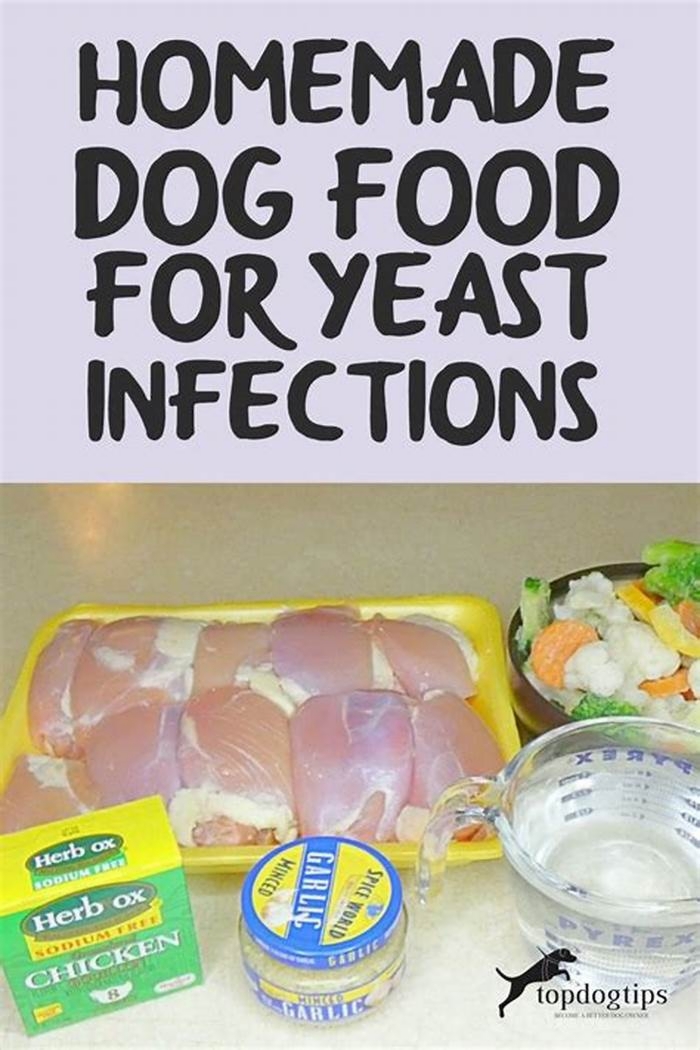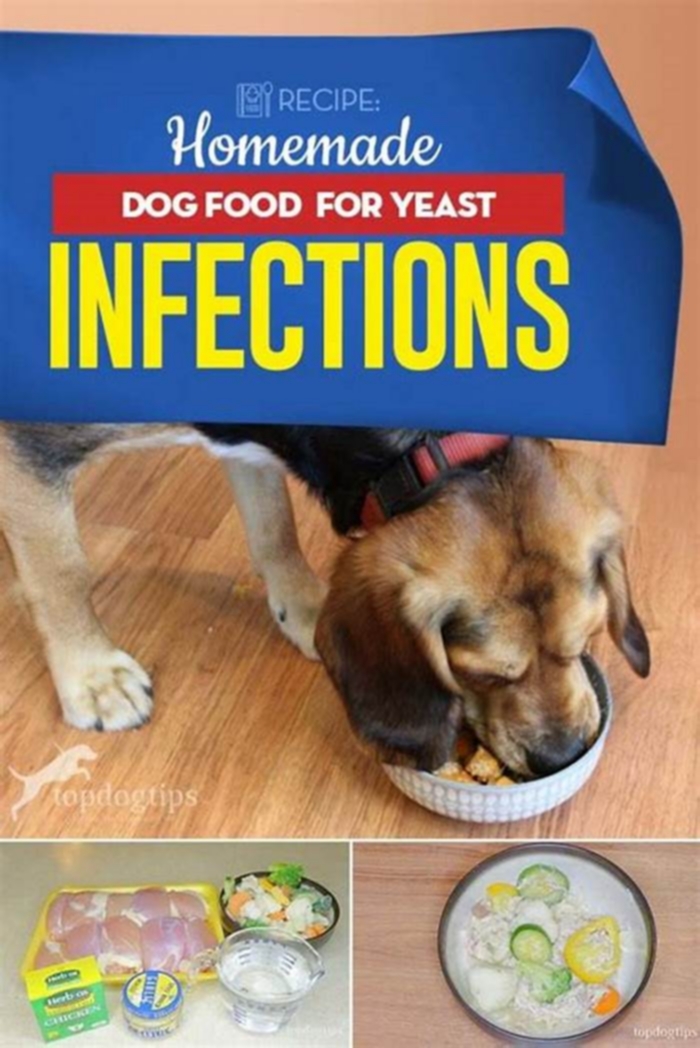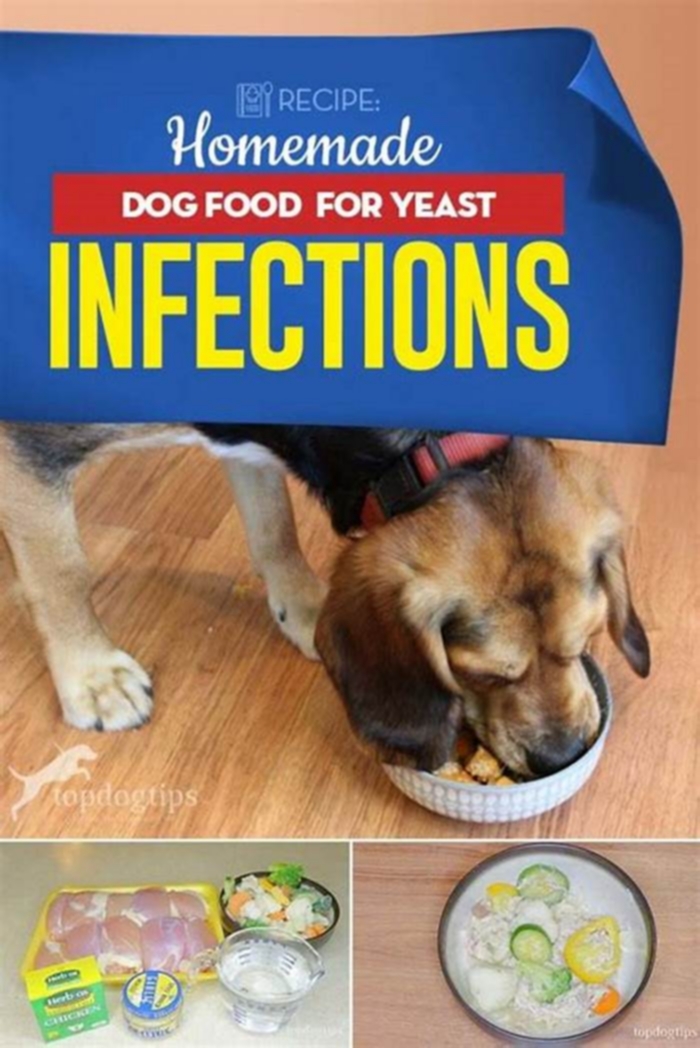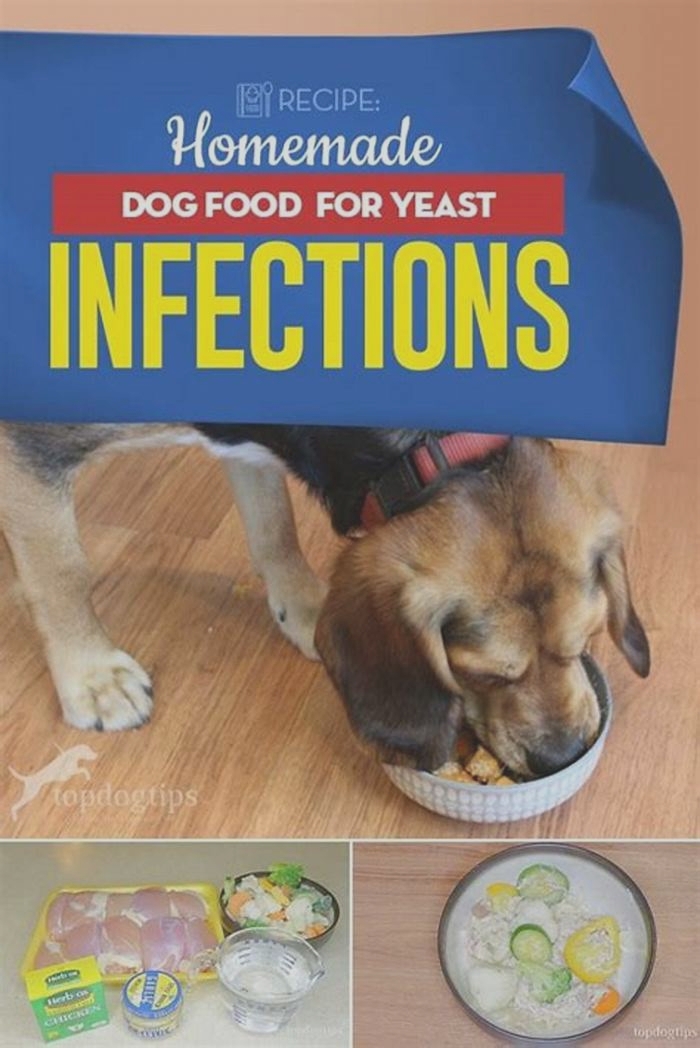yeast free homemade dog food recipe
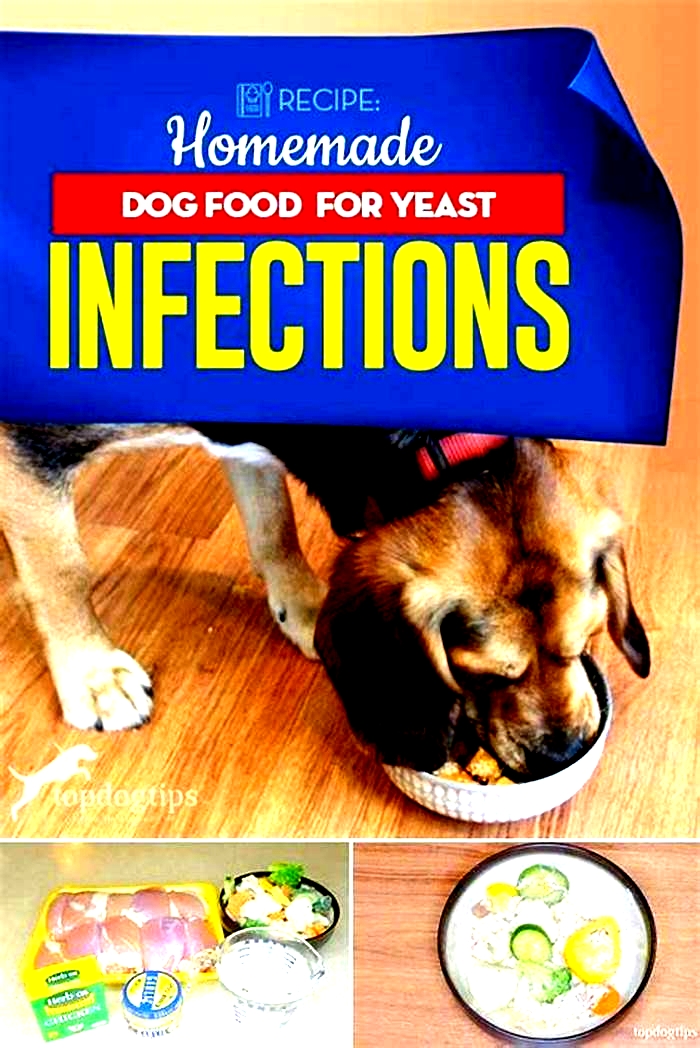
Recipe: Homemade Dog Food for Yeast Infections
Yeast infections are a fairly common skin condition in dogs.
They are typically not something to worry about, but you should seek veterinary care to get the condition cleared up as soon as possible.
What's a yeast infection all about?
This is a skin infection known as yeast dermatitis where 1 particular type of yeast Malassezialives on your dog's skin all the time.
It does not typically cause problems, except for cases of overpopulation.
So today, I came up with this homemade dog food for yeast infections for your Fidos.
This should help clear up skin conditions associated with an overgrowth of yeast.
Let's get cooking, shall we?
 Dog Food for Yeast Infections: Overview
Dog Food for Yeast Infections: Overview
This homemade dog food for yeast infections is also known as a yeast starvation diet. It will help to treat the infection, and then your dog should be gradually returned to his regular diet.
Note: This diet will not provide balanced nutrition for your dog.
If your dog suffers from chronic yeast infections, consult a canine nutritionist about the best yeast starvation to meet his needs.
This recipe may be a good option for your pet, but a canine nutrition expert will likely recommend supplements and/or a multivitamin.
Homemade Dog Food for Yeast Infections Recipe
 Ingredients
Ingredients
- 3 lbs. boneless, skinless chicken thighs
- 2 chicken bouillon cubes
- 2 cloves garlic
- 1 lb. frozen vegetables
Most experts recommend a diet free of grains, potatoes, and yeast if you're trying to make yeast-starvation dog food.
As you can see, this recipe follows those guidelines. However, there is one ingredient that I am often asked about garlic.

Garlic on Dog Food for Yeast Infections
Most pet owners are under the impression that garlic is toxic to dogs.
This is only true for large quantities of garlic.
In moderation,garlic is actually a very beneficial ingredient for canines.
Foods in the genus Allium, like garlic, onions, and leeks were once considered incredibly dangerous for dogs.
But, according to the Journal of Venomous Animals and Toxins including Tropical Diseases:
garlic, on the other hand, is considered to be less toxic and safe for dogs than onion when used in moderation.
Garlic has natural anti-parasitic, anti-fungal, and antibiotic properties.
As I mentioned, this recipe should not be fed for a long period of time.
It will help to treat the infection, and then your dog should be gradually returned to his regular diet.
Directions
Making this homemade dog food for yeast infections is quite simple.
It's a slow cooker recipe, so it's great if you work outside the home and want to prepare homemade food for your pet.
 Step 1: Add the chicken, garlic, bouillon, and water to your slow cooker.
Step 1: Add the chicken, garlic, bouillon, and water to your slow cooker.
Step 2: Cook on low for 6 hours. If you will be out of the house for more than 6 hours, that's okay. Your slow cooker will automatically shut off or switch to a warm' setting after 6 hours.
Step 3: Add the vegetables and cook on low for another 30 minutes. When the homemade dog food for yeast infections is cooled, you can serve it to your dog.
The recommended serving size is about 1/2 cup for every 20 pounds of body weight. You should feed 2 servings per day.
Keep in mind that exceptionally active dogs will require more calories, while less active dogs may not require as many.
You can store leftovers in the refrigerator in an airtight container for up to 6 days.
Do you want Other Options for Dog Food for Yeast Infection? Follow these Rules and Tips
If your dog is prone to yeast infections, then your vet may suggest an anti-yeast diet.
The above dog food recipes are a good starting point, but you can also get creative as long as you know what to include and what to exclude.
Stick to Raw Food
Giving your dog a raw diet is a good choice if he has regular yeast infections. A raw diet is similar to the meat-based diet of your dog's ancestors.
Most importantly for the yeast infection, there will not be processed carbs that will feed the yeast.
Try a Limited-Ingredient Diet
If you don't want to give your pup a raw diet, you can also look for limited-ingredient commercial food.
Because these foods have fewer ingredients, they tend to have fewer low-quality carbs.
Always Minimize Processed Foods
Even if you don't give your dog a raw diet or homemade food, make sure that you stay away from overly-processed foods.
Some ingredients to avoid include excessive starch, high-fructose corn syrup, and corn fillers.
Avoid Natural Sugars
You don't just want to avoid processed sugars and carbs. Dogs with yeast infections should also avoid natural sugars.
Remember that the glucose in the sugar will feed the yeast.
Go Grain-Free
Because carbohydrates fuel yeast infections, dog owners should also strongly consider a grain-free diet.
Prioritize Protein
When creating your pup's new diet, focus on protein. Remember to focus on unprocessed meats.

Dog Food For Yeast Infections: What to Avoid
Common veterinary advice for dogs with yeast infections includes the following list of foods to avoid:
- Bread
- Bacon
- Peanuts
- Pretzels
- Sausage
- Crackers
- Potatoes
- Buttermilk
- Lunch Meat
- Mushrooms
- Gravy or sauce
- Packaged cereal
- Sweet Potatoes or Yams
- Cheese or cottage cheese
- Anything else with grain or sugar
Dog Food For Yeast Infections: What to Include
You can also get creative with a dog food recipe that has the following ingredients, all of which are good for controlling yeast infections in dogs:
If you opt for homemade dog food, always make sure to plan the recipe carefully so your dog gets all the nutrients he needs.
If you haven't made your pup a meal before, start with dog food recipes to get an idea of the proper balance.
What are the Signs of Yeast Infection in Dogs?
If your dog is scratching his ears nonstop and has cracked lips or red, inflamed skin, it could be a sign that it has a yeast infection.
Chewing of the paws is another sign of a yeast infection in dogs, as the yeast can build up between the toes and cause irritation.
Finally, if the red, itchy skin is accompanied by a foul smell, it's very likely that your dog has a yeast infection.
Home remedies may get rid of a yeast infection in dogs, but your veterinarian can also prescribe a topical cream to help treat the condition quickly.
The Role of Pet Foods in Yeast Infections
The environment is not the only factor influencing whether your dog develops a yeast infection; his diet also plays a role.
To survive and grow, yeast needs energy in the form of glucose.
This glucose comes from carbohydrates and starches.
The problem is that many low-quality foods have low-quality carbohydrates, as they are popular, cheap fillers.
These fillers have minimal nutrition but have all the nutrition that yeast needs.
In other words, a low-quality diet can increase the risk of a skin infection or other types of yeast infections.
Feeding your furry friend anti-yeast dog food is a simple way to overcome this challenge. Watching what your dog eats doesn't have to be overwhelming.
While we offer the above recipe, dog owners with less time on their hands can also find commercial options that are right for your dog's diet.
Common Questions About Homemade Yeast Starvation Dog Food
If you still have some doubts about yeast-free dog food, the following information should answer your lingering questions.
What Do You Feed a Dog with a Yeast Infection?
A raw diet is a very popular option for an anti-yeast diet. You can also opt for a partially raw diet.
If you don't have time to make homemade food, consider a commercial homemade diet.
What Food Kills Yeast in Dogs?
Anti-fungal foods for your dog include items with olive leaf, Pau D-Arco, and caprylic acid.
How Do I Reduce My Dog's Yeast Infection?
If your dog is dealing with yeast infections, your vet will likely suggest yeast-free dog food along with topical treatments.
Examples of topical treatments include antifungal creams, shampoos, sprays, and wipes with ketoconazole, miconazole, or chlorhexidine.
Will Yogurt Help My Dog's Yeast Infection?
Yes, yogurt is a good food to include in an anti-yeast diet. This is because of the probiotics, which can fight yeast infections.
For the best results, choose a natural, probiotic yogurt without added sugar.
Dog Food for Yeast Infections: Before You Go
When your dogs are suffering from illnesses or infections, the best way to alleviate pain is to quickly have them assessed by your vet.
But it just doesn't end there.
Your dogs need your support and aftercare, too.
That's when Top Dog Tips steps in.
Hopefully, this dog food recipe for yeast infections can help you get started.
So, if you enjoyed this blog, you might find the following articles helpful, too!
READ NEXT:
WANT TO SHARE THIS

Homemade Vegan Dog Food: 10 Vet-Approved Recipes, Ingredients & Diet Plan
Canine Bible is reader-supported. We receive affiliate commissions via some of our links. This doesnt affect rankings. Learn more.
This content was reviewed and fact-checked by veterinarian Dr. Aukse Caraite, DVM.
This is the most comprehensive guide to homemade vegan dog food. Going vegan is a personal choice that can also extend to our furry friends. However, cooking veggie-based food for dogs requires careful planning and important guidelines you need to follow. If you want to learn how to make vegan dog food at home, we cover everything from the basics of vegan dog food nutrition to the best homemade vegan dog recipes, ingredients, and everything you need to know about vegan dog meals. Lets dive right in!
Table of contents
In This Article:Table of contents
In This Article:Nutrition, Benefits & RisksJump to:Recipes & Cooking
Can Dogs Eat Homemade Vegan Dog Food?
Dogs can eat homemade vegan recipes, but there are important considerations to keep in mind. Dogs are omnivores and can thrive on a well-planned plant-based diet as long as it is balanced and meets its unique nutritional requirements.
Why Feed Homemade Vegan Food to Your Dog
Increased lifespanResearch shows that dogs eating fresh diets are linked to a20% longer lifespanthan those that dont. A year-long study of 522 dogs found that dogs fed high-quality, freshly made, real food had an average life expectancy of13.1 yearsversus just 10.4 years for dogs fed commercially processed pet food.[1] Digestive healthPlant-based diets are often high in fiber, aiding digestion and promoting gut health. This can be particularly beneficial for dogs with certain digestive issues. Homemade dog food is easier to digest than hard kibble, putting less stress on their digestive system and liver and reducing the likelihood ofbloating or other digestive issues.Obesity & jointsVegan dog food can be lower in calories and fat compared to meat-based diets, which can help manage weight, especially for dogs prone to obesity. Obesity in dogs can increase their risk forbone and joint problems (i.e., hip dysplasia) and subsequent osteoarthritis. Studies show that dogs maintaining theirideal body weightlive almost 2.5 years longer (with significantly fewer diseases) than their overweight siblings..[2] Ethical considerationsFor pet owners concerned with animal welfare and ethical issues surrounding animal farming, a vegan diet for their dogs can align more closely with their values.Cancer preventionWhen it comes tocancer, homemade dog food removes the highly processed food from the equation, which is often linked tocancer issues in dogs. Food processing has been shown to cause free radicals and carcinogenic chemicals to be released. With homemade, you no longer have to worry about oxidative stress due to processed food.[3],[4]Avoid allergiesSome dogs are allergic to common meat proteins. A vegan diet can be beneficial in managing these allergies, as it avoids these allergens. Cooking at home also lets you pick ingredients that wont trigger allergies. If you are unsure what ingredients may cause sensitivities or allergies in your pet, we advise doing anat-home dog food allergytest before selecting the ingredients for your dogs next meal.BioavailabilityHome-cooked dog food is easier to digest more digestible food means dogs can absorb nutrients more efficiently and faster. Quicker nutrient absorption means minerals, vitamins, fatty acids and amino acids act quicker in the body to carry out different functions, such as decreasing inflammatory responses that can help prevent allergies or help boost overall health. Fresh ingredients with no chemicalsHomemade meals ensure your dog always eatsfresh, wholesome, and chemical-free foods without additives, fillers, high-glycemic carbs, or colorants commonly found in kibble. Reduced environmental impactPlant-based diets generally have a lower environmental footprint compared to meat-based diets. You can reduce the carbon pawprint associated with pet food production by choosing vegan dog food.Potential health benefitsA plant-based diet may improve a dogs health, such as better coat condition, fewer skin problems, and more energy, and better stools.Homemade Vegan Dog FoodRisks
Research by the University of California Davis, School of Veterinary and two studies published in The JournalPreventive Veterinary Medicine and The Journal of Nutritional Science found that most homemade dog food recipes lackkey essential nutrients, and other recipes used dangerously high levels of some nutrients.[5],[6]
48%
of homemade dog dietshad an imprecise determination of ingredients and quantities
28.3%
didnt use any recommended vitamins, minerals, or amino acids.
30.4%
of the pet parents admittedto purposely changethe recipe.
40%
of owners didnt measure the proportions of the ingredients well enough.
Key Considerations When Feeding Your Dog A Vegan Homemade Recipe
- Understand your dogs nutritional needs
- Do not use inadequate or dangerous recipes
- Ensure your dogs meal is balanced
- Do not use toxic ingredients
- Understand the impact of food and dietary changes
- Do not neglect your dogs health conditions
- Switch to homemade gradually
- The diet must be based on your dogs life stage nutritional needs (puppies, adults or seniors)
You can get personalized nutritional advice from a registered vet nutritionist through Vetster anytime, anywhere. You can also chat with an online vet and ask them questions about your dogs nutritional needs.
How to Make Vegan Dog Food
Vegan homemade food for dogs must include the six essential nutrients for proper growth, body function, and health. These nutrients include proteins, carbohydrates, minerals, vitamins, fats, and water.
Below is a detailed breakdown of each nutrient and its importance.
Dog Vegan Recipe Nutritional Guidelines
Proteins
Protein plays a vital role in your dogs diet, providing essential amino acids necessary for bodily processes, including the creation of blood glucose for energy. Protein also helps build and repair muscles and other body tissues. Its needed to make new skin cells, grow hair, hormones and enzymes. The proteins in your dogs diet must have a balanced amino acid profile and are provided in appropriate amounts.
Protein dietary recommendations for dogs vegan homemade food:
- Adult Dog. 18% dry matter protein (45.0g for every 1,000 kcal ME).
- Puppies & Pregnant or Lactating Dog. 22.5% dry matter protein (56.3g for every 1,000 kcal ME).
Protein sources for homemade vegan food include:
- Lentils
- Green peas
- Yeast
- Chickpeas
- Tofu
- Oats
- Quinoa
Carbohydrates
Dogs need energy for daily activities like growth, pregnancy, lactation, and exercise. This energy, measured in calories, comes from carbohydrates, proteins, and fats. Dogs, derive some energy from carbohydrates. Carbohydrates supply glucose needed by the brain, nervous system and other critical organs for normal function in dogs.
Energy dietary recommendations based on life stage, weight and activity level.
| Type of Dog | 10 lb | 30 lb | 50 lb | 70 lb | 90 lb |
|---|---|---|---|---|---|
| Puppies | 990 | ||||
| Inactive Dog | 296 | 674 | 989 | 1,272 | 1,540 |
| Adult Active Inactive Dog | 404 | 922 | 1,353 | 1,740 | 2,100 |
| Pregnant Dog | 518 | 1,274 | 1,940 | 2,570 | 3,170 |
| Young Active Dog | 436 | 993 | 1,451 | 1,876 | 2,264 |
| Senior Active Dog | 327 | 745 | 1,093 | 1,407 | 1,700 |
Carbohydrate sources for homemade vegan recipes include:
- Oats
- Brown rice
- Potatoes
- Quinoa
- Sweet potatoes
- Whole wheat
Fats
Fats play a multifaceted role in a dogs diet. They are a dense energy source, provide essential fatty acids for skin and coat health, enable absorption of fat-soluble vitamins, improve food palatability, offer insulation and organ protection, support reproductive health, are critical for nervous system function, and serve as a reserve for energy storage.
Fat dietary recommendations for vegan homemade dog food:
- Adult Dog. 5.5% dry matter fat (13.8g for every 1,000 kcal ME).
- Puppies & Pregnant or Lactating Dog. 8.5% dry matter fat (21.3g for every 1,000 kcal ME).
Fat sources for vegan dog food recipes:
- Flaxseed oil
- Coconut oil
- Olive oil
- Sunflower oil
- Canola oils
Minerals
Minerals in a dogs diet are indispensable for bone and dental health, nerve function, enzymatic reactions, fluid balance, oxygen transport, and maintaining the bodys pH level, making them essential for overall health and metabolic processes. Proper mineral balance is crucial and should be carefully managed to avoid deficiencies or excesses.
These 12 minerals are known to be essential nutrients for dogs:
- Calcium
- Potassium
- Sodium
- Magnesium
- Iodine
- Chlorine
- Iron
- Copper
- Selenium
- Manganese
- Zinc
- Phosphorus
Mineral sources for vegan dog food recipes include:
- Kale and broccoli (Calcium)
- Sweet potatoes and pumpkin (Magnesium)
- Kelp (Iodine)
- Whole grains (Zinc)
- Nuts and legumes (Copper)
- Bananas and carrots (Potassium)
- Peas (Phosphorus)
- Spinach and lentils (Iron)
Vitamins
Vitamins in a dogs diet are integral for maintaining overall health and bodily functions. They support vision, immune health, aid in energy metabolism and nervous system function, provide antioxidant benefits, reduce inflammation, prevent diseases and ailments and more. Dogs require vitamins, but only in small amounts, and excessive doses of certain vitamins, like vitamin D, can harm them.[9]
These 12 vitamins are known to be essential nutrients for dogs:
- Vitamins A, B1, B6, B12, D, E & K
- Riboflavin
- Niacin
- Folic Acid
- Pantothenic Acid
- Choline
Vitamin sources for homemade vegan dog food include:
- Sweet potatoes and spinach (Vitamin A)
- Sunflower seeds and kale (Vitamin B)
- Broccoli (Vitamin C)
- Kale and parsley (Vitamin K)
- Cooked asparagus (Riboflavin)
- Vegetables (Vitamin E)
Vitamins
Water is vital in a dogs diet for maintaining hydration, supporting body functions such as digestion, nutrient absorption, and waste excretion, lubricating joints, regulating body temperature, ensuring proper organ function, and facilitating metabolic processes. Continuous access to clean water is as crucial as providing nutritious food for overall health and well-being. Generally, dogs should drink 2 to 3 times the amount of their dry food intake daily. However, if water is readily available from various sources, dogs can naturally regulate its water consumption each day.
Source: We compiled the data for the table above by referencing the Association of American Feed Control Officials (AAFCO) guidelines and the Nutrient Requirements of Dogs Report by the National Research Council (NRC). The AAFCO is responsible for setting nutritional value standards for commercial dog food, which are recognized by state, federal, and international feed regulators. The NRC, part of The National Academies of Science, Engineering, and Medicine, publishes authoritative reports. The Food and Drug Administration (FDA) utilizes the information from these reports to regulate and ensure the safety of pet foods.
Vegan Dog FoodIngredients
Heres a handy list of ingredients to consider as you plan your homemade vegan dog food.
| Proteins | Carbohydrates | Fat | Vegetables | Fruits |
|---|---|---|---|---|
| Lentils | Potatoes | Hemp oil | Cucumbers | Cantaloupe |
| Chickpeas | Sweet potatoes | Flaxseed oil | Broccoli | Apples(remove the seeds) |
| Peanuts | Rice | Coconut oil | Dark, leafy greens | Bananas |
| Almonds | Barley | Olive oil | Carrots | Blueberries |
| Spirulina | Oats | Sunflower oil | Kale | Mangoes |
| Quinoa | Wheat | Hemp oil | Spinach | Peaches |
| Chia seeds | Millet | Sesame oil | Corn | Pears |
| Hemp seeds | Brown rice | Artichokes | Pineapple | |
| Beans | Couliflower | Raspberries | ||
| Soybeans | Celery | Strawberries | ||
| Barley | Asparagus | Watermelon | ||
| Buckwheat | Sunflower | Melons | ||
| Green Peas | Pumpkin | |||
| Protein-richvegetables | Zucchini |
Beans can cause flatulence in dogs; be mindful of how often and how much you feed them.
Vegan Homemade Dog Food Tips
Keep these tips in mind to help you plan your veggie-based dog meals.
- Set a consistent feeding schedule
- Meal prep weekly or monthly
- Measure and controlportionsizes depending on your dogs calorie needs
- Keep mealsfrozen for 2 to 3 months or refrigerated for about five days
- Make a new batch when the food supply is getting low
- If you want to feed different recipes, you can make multiple batches and color code by ingredients, rotating out the different meals
- Prepare the food in bulk and portion it into containers (one container per meal makes it extra easy)
- Increase portions appropriately as your puppy grows
- Monitor weight to make sure you are feeding the proper amount of calories
Recipes, Cooking Tips & MoreJump to: Benefits & Nutrition
Vegan Dog Food Recipes
Browse our favorite vet-approved homemade vegan dog food recipes that will make your pup beg for more. Weve also included a special treat recipe for your dog, enriched with the health benefits of our favorite ingredient: dog CBD oil. CBD oil might help with issues like seizures, anxiety, arthritis, inflammation, pain, and overall wellness.
Note:Consult your vet before adjusting your dogs diet. The recipes below dont specify serving sizes since they depend on your dogs breed, weight, age, activity, and health. As a guideline, consider feeding the equivalent amount youd give in kibble, but always consult your veterinarian for proper portioning.
1. Vegan Quinoa & Vegetable Dog Food
Vegan Quinoa & Vegetable Dog Food
Canine BibleThis recipe, carefully researched for safety and nutrition, is perfect for my dogs Bandit and Pepe. Before introducing any new ingredient in their diet, I always test it in small amounts to see how they tolerate it. I encourage you to do the same. This approach has been invaluable in keeping their tummies happy and their tails wagging. It's packed with beneficial ingredients like butternut squash, lentils, and blueberries, providing a variety of nutrients. The quinoa in this recipe is a fantastic source of plant-based protein, and the added veggies ensure they're getting a rainbow of vitamins and minerals.
Prep Time 15 minutes mins
Cook Time 50 minutes mins
Large pots
Potato masher
Containers
- 1 cup quinoa, rinsed
- 1 cup chopped butternut squash
- cup dry green lentils
- 1 cup chickpeas, soaked overnight or 1 cups cooked
- 1 1 lb bag organic frozen mixed vegetables (like carrots, peas, and green beans), thawed
- 1 small sweet potato, cooked and mashed
- cup pumpkin puree (ensure it's plain pumpkin, not pie filling)
- 1/2 cup blueberries (fresh or frozen)
- 1/4 cup ground flaxseed
- 6 cups water
- 1 tbsp nutritional yeast (optional, for added B-vitamins)
- A handful of chopped kale or spinach (optional)
Prepare Quinoa and Lentils: In a large pot, combine quinoa, lentils, and water. Bring to a boil, then reduce heat and simmer until both are cooked and tender, about 20-25 minutes.
Cook Squash and Chickpeas: In a separate pot, boil the butternut squash until tender. Drain and set aside. If using uncooked chickpeas, cook them until they are soft.
Combine Ingredients: Once the quinoa and lentils are cooked, add the cooked butternut squash, chickpeas, mixed vegetables, mashed sweet potato, pumpkin puree, blueberries, and ground flaxseed to the pot. Stir well to combine.
Add Greens and Nutritional Yeast: If using, add the chopped kale or spinach and nutritional yeast. Stir until the greens are wilted.
Cool and Store: Allow the mixture to cool completely. Portion the food into containers with tight lids and refrigerate or freeze for future use.
2. Meat-Less Homemade Dog Food
This recipes is designed as a healthy option for dogs. It includes sweet potatoes, peanut butter, brown rice, quinoa, lentils, apple cider vinegar, cranberry juice, and coconut oil. Dogs might love this recipe due to its variety of flavors and soft, wet consistency, which is similar to canned dog food.
3. Homemade Vegan (Whole Foods Plant-Based) Dog Food
This recipe is rich in fiber, essential for a healthy digestive system. Its made with ingredients like brown rice, lentils, garbanzo beans, various organic vegetables. Its soft and mushy consistency is especially appealing to dogs that prefer soft-textured foods.
4. Cassys Favorite
This recipe is great for dogs due to its nutritional richness and balance. Organic Indian basmati rice, tofu, black beans, garbanzo beans and red quinoa offer healthy carbohydrates and proteins. Mixed vegetables contribute essential vitamins and minerals, enhancing overall nutrition. Nutritional yeast provides B-vitamins, while ground flax seed is an excellent source of omega-3 fatty acids, beneficial for skin and coat health.
5. Vegan Dog Food Recipe + Vegan Kibble
The recipe combines a variety of healthy ingredients including basmati rice, quinoa, vegetables, and beans, enriched with nutritional yeast, flax seed, and oil. Its designed to offer a balanced diet and add variety to a dogs meals, making it particularly appealing for those looking to incorporate plant-based options.
6. Veggie Tumeric Mix
Chef Jana Pinheiros vegan dog food recipe is beneficial for dogs due to its blend of nutritious ingredients like cooked chickpeas, broccoli, spinach, brown rice, sweet potatoes, and turmeric. These ingredients offer a mix of protein, fiber, vitamins, and minerals essential for a dogs health.
7. Homemade Dry Vegan Food
The recipe involves baking a puree of these ingredients to create a dry food, similar to commercial kibble, but with the benefits of homemade preparation. Dogs would likely enjoy this for its variety of flavors and the crunchiness of the dry food.
Vegetarian Dog Food Recipes
Looking for vegetarian dog food recipes? Thesehomemade vegetarian dog food recipes vet approved can get you started. Remember, the key distinction between vegetarian and vegan diets for dogs is that vegetarian options may include animal-derived ingredients like cream cheese, but like vegan diets, they dont contain meat.
8. Black Bean, Quinoa & Spinach Mix
This vegetarian homemade dog food recipe combines nutritious ingredients like cooked black beans, quinoa, spinach, butternut squash, apples, pears, zucchini, plain yogurt, and low-fat cream cheese. Its super tasty and provides a balanced and enjoyable meal.
9. Banana, Quinoa & Veggie Mix
This recipes is simple, using ingredients like quinoa, sweet potato, frozen peas, and banana. This recipe is great for dogs due to its healthy and easy-to-digest ingredients, providing essential nutrients without meat. The combination of quinoa and sweet potato offers both protein and carbohydrates, while peas and banana add vitamins and fiber.
10. Homemade Vegetarian Dog Food With Eggs (Doggie Veggie Frittatas)
This vegetarian dog recipe is great for dogs as its a nutritious and enjoyable treat. Made with finely chopped veggies like spinach, kale, carrots, zucchini, and broccoli, its rich in vitamins and fiber. Eggs add protein, and the optional turmeric and black pepper offer anti-inflammatory benefits.
More Vegan Dog Food Recipes
To learn more about vegan dog nutrition or find more easy vegan dog food recipes, check outPlant-Based Recipes for Dogs: Nutritional Lifestyle Guide by Heather Coster. This vegan dog recipe bookshows you exactly how to create nutritionally balanced vegan dog food recipes that are sure to win over even the fussiest eater.
Homemade Vegan Dog Food Recipe Delivery Service
WILD EARTH
Who Its For: The perfect homemade vegan dog food alternative if you dont have time to cook for your dog or are unable to balance nutrients to provide a balanced diet.
Does vegan cooking food sound stressful? Dont have the time? Feel lost when it comes to balancing plant-based ingredients? If you answered yes to any of these questions, you can still provide the benefits of a vegan diet to your dog without going through the hassle of cooking it. Weve compiled a list of the best commercially available veg dog food recipes. These vet-approved vegan dog food recipes meet all the nutritional requirements dogs need to thrive.
Our top recommendation is Wild Earth this vegan dog food company appeared on Shark Tank. Its veterinarian-approved recipe is made from plant-based and cruelty-free ingredients for healthier pets. They use only clean, sustainable and tasty plant proteins that offer more protein by weight than traditional dog foods. Its formula is boosted with superfoods including chickpeas, sweet potato, spinach, pumpkin and oats and more. 86% oftheircustomers report that Wild Earth has improved their dogs health. Want more options? Below you can check out our best vegan dry dog food recipes. Your pup is sure to love these vegan dog kibble recipes.
Our readers get 50% offtheir first Wild Earth vegan kibble order with Canine Bibles link.
What Vegan Foods Should Your Dogs Never Eat?
Stone fruits such as cherries and peaches contain seeds that can cause cyanide poisoning. Similarly, grapes and raisins may cause kidney failure, and too many onions and garlic can cause hemolytic anemia, among other problems. Here is a non-exhaustive list of foods a dog shouldnt eat to avoid these types of problems.
- Cherries
- Peaches
- Plums
- Grapes
- Raisins
- Mushrooms
- Onions
- Garlic
- Tomatoes
- Macadamia nuts
- Walnuts
- Pistachios
Check out this handy list for a comprehensive list of all foods to avoid. Please print it out and put it on your refrigerator as a reminder.
How to Transition Your Dog To A VeganDiet
There are some dogs with sensitive GI tracts. To prevent stomach issues, you should transition to vegan dog food gradually. Here are the general guidelines you should follow when transitioning to a new diet.
- Week 1:25% new food and 75% old food
- Week 2:50% new food and 50% old food
- Week 3:25% new food and 75% old food
- Week 4:100% new food
Some dog owners opt to begin with 50% to simplify things but start with 25% (or a smaller percentage, like a Tablespoon) if your dog is hypersensitive. Consider extending the transition time to 5 weeks or longer if you feel it will be easier for your dog to adjust. Changing your dogs food abruptly is not recommended. This may result in upset stomachs, diarrhea, or vomiting.
Vegan Nutritional Risks & Supplementation
Its common for vegan diets to lack B vitamins,calcium, phosphorus and iron. A plant-based diet can also be deficient in fatty acids and amino acids,particularly taurine and L-carnitine. Consider adding the supplementation if your dogs vegan meal plan (ingredients) does not provide the nutrients and vitamins mentioned above.
Monitor Weight And Health
A dogs weight and gut health are essential indicators of their health, and you need to track them when switching to a new diet (i.e., homemade). Maintaining a healthy weight is easier when your dog is fed the right dog food. If your dogs weight increases or decreases rapidly, it might be due to food-related health issues. A healthy gut can confirm a smooth transition to your dogs new diet, among other health issues. However, identifying a healthy gut is not an easy task. Fortunately, an at-home dog gut health test can provide insight into your dogs gut health.
Skin or coat issues, excessive tiredness, allergies, weight loss, malnutrition, and obesity can be caused by unbalanced and insufficient meal plans. If you detect any of these symptoms while feeding your dog meals, stop doing it immediately and seek expert advice.
Vegan Dog Food Recipes Conclusion & Alternatives
Homemade vegan dog food can be a healthy and affordable option for your pet. It is essential to consider your dogs nutritional needs when preparing their food and consult with a veterinarian if you have any questions about whether a vegan diet is appropriate. By following these simple tips, you can ensure that your furry friend enjoys a delicious and nutritious meal that meets their dietary needs. The raw pet food trend is in vogue just as much as a plant-based diet for dogs. Learn all about it in our raw dog food guide.
Like It? Subscribe & Share!
Sources
Canine Bible uses only high-quality sources, including peer-reviewed studies, to support the facts within our articles. Read oureditorial processand product review methodology to learn more about how we fact-check, test products, and keep our content accurate, reliable, and trustworthy.
[1]Lippert & Sapy[2]AVMA[3]Lyka, [4]Hardvard[5]NCBI, [6]PubMed, [6]UC Davis
Like It? Subscribe & Share!
Canine Bible authorship represents the unified voice of our entire editorial team and our in-house veterinarians rather than a single author. Each article, blog post, and review published under the Canine Bible name undergoes a rigorous review process, involving all team members to guarantee accuracy and up-to-date in accordance with the latest veterinarian research. This collaborative effort is an integral part of our editorial process and aligns with our four pillars of content creation. This approach ensures our content is backed by expert knowledge and factual information, offering our readers reliable, actionable, and trustworthy content.

